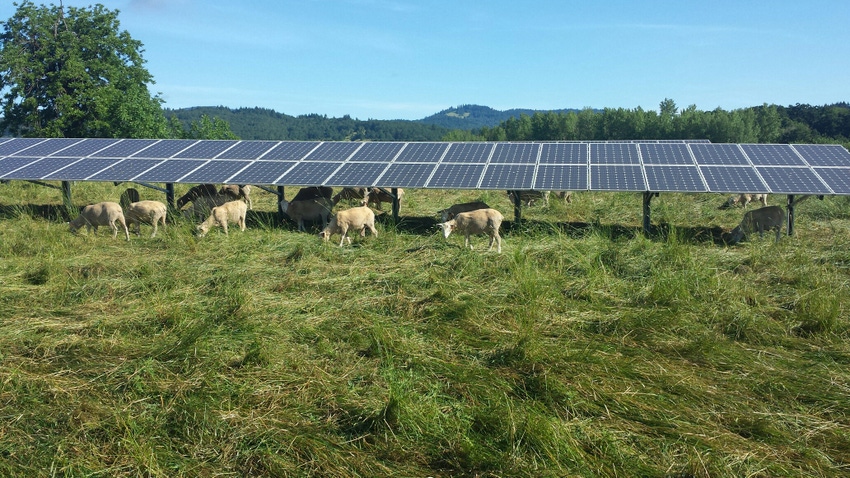Concept of co-developing same land for both solar photovoltaic power generation and conventional agriculture, known as agrivoltaics, dates to early 1980s.
November 6, 2018

Alternative forms of energy production have gained attention as technologies have advanced and costs have come down. For example, dedicated solar farms with acres of panels to generate energy have become common as a means to reduce reliance on fossil fuels.
Now, Oregon State University scientists have found a resource to increase agricultural production on dry, non-irrigated farmland: solar photovoltaic panels.
In a study published in the journal PLOS One, a research team with Oregon State's College of Agricultural Sciences found that grasses favored by sheep and cattle thrived in the shade of a solar array installed in a pasture on the Oregon State campus.
The results of the study indicate that locating solar panels on pasture or agricultural fields could increase crop yields, said corresponding author Chad Higgins, an associate professor in the department of biological and ecological engineering.
“There are some plants that are happier in shaded environments,” he said. “The amount of water that went into the making those plants is tremendously smaller than in the open field. You get double the yield, less water and all the solar energy.”
The concept of co-developing the same area of land for both solar photovoltaic power and conventional agriculture, known as agrivoltaics, dates to the early 1980s, the university explained. Ground-mounted solar arrays typically aren’t placed on farms with the intent to grow crops.
“The idea of locating solar panels on farm isn’t new,” Higgins said. “The difference here is that this solar array was installed without the intent to influence plant production. It was by accident. Nobody engineered this system. Now, we’re trying to develop a deeper understanding of how we can engineer the system to be technically feasible, environmentally sound and economically viable.”
Oregon State said it has solar project sites in Corvallis, Ore., covering 10 acres that have the capacity to generate 2.6 million kWh of power per year. This study focused on the 35th Street Solar Array installed in 2013 on the west side of campus.
Walking past the array one day, Higgins and colleagues noticed green grass growing in the shade of the panels. In May 2015, they installed microclimate research stations that recorded mean air temperature, relative humidity, wind speed, wind direction and soil moisture. By August, the instrumentation revealed that the areas under the solar panels maintained higher soil moisture throughout the three-month period.
The result was striking, Higgins said. The areas under the array produced double the amount of plant material as the unshaded areas, including an increase in the nutritional value of plants. The researchers also noted a significant increase in late-season plant growth.
“It’s like a tortoise and a hare race,” Higgins said. “The plants that experience the full brunt of the sun use their water resources as quickly as possible. They grow to the extent they can, and then they die. On the other hand, the plants in the shade take sips of water because they are less stressed, and they keep chugging along.”
The next step is to test the effect of solar panel placement on certain high-value crops that are suitable to shady conditions, Higgins said.
The study is part of a larger effort to understand links among energy, water and food systems, according to Higgins, founder of the Nexus of Energy, Water & Agriculture Laboratory at Oregon State. The research team included Elnaz Hassanpour Adeh, a doctoral candidate in the university's water resources engineering program, and distinguished professor John Selker in the department of biological and ecological engineering.
You May Also Like


.png?width=300&auto=webp&quality=80&disable=upscale)
